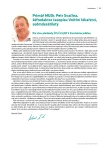Basic principles and difficulties relating to rehabilitation in diabetic patients following amputation
Authors:
Martin Jindra; Bohuslava Věchtová; Jana Bielmeierová
Authors‘ workplace:
Rehabilitační klinika LF UK a FN Hradec Králové, přednostka doc. MUDr. Eva Vaňásková, Ph. D.
Published in:
Vnitř Lék 2015; 61(6): 604-608
Category:
Předneseno na mezioborovém sympoziu s postgraduálním zaměřením „Diabetik – společný pacient diabetologa a ortopeda“ 10. října 2014 v Hradci Králové.
Overview
Vascular diseases as a result of diabetes mellitus are the most frequent indication for amputation in the Czech republic. Diabetic patients following amputation, unlike the other amputees, very frequently suffer multiple complications. These are both of general and local nature and pose a limitation to rehabilitation care as well as a prosthesis use. The main goal of therapeutic rehabilitation is the practice of locomotion with a prosthesis (artificial limb) and the patient‘s full return to normal life. A team of closely cooperating specialists is involved. The rehabilitation care of amputees is divided into acute and aftercare. Within preoperative care we try to improve the patient‘s physical and psychological condition. Following surgery we verticalize the patient as soon as possible depending on his/her possibilities and condition, we carry out breathing and vascular gymnastics and prevention of thromboembolic disease and we start the care of the stump. When the stump has been healed and shaped, the patient is provided with an artificial limb. The patients equipped with an artificial limb take a walking course where they learn how to handle the limb as well as walk indoors and outdoors and cope with common terrain unevenness.
Key words:
amputation – diabetes mellitus – walking with an artificial limb – prosthesis – lower limb prosthetics
Sources
1. Kubeš R. Amputace. In: Dungl P et al. Ortopedie. Grada: Praha: 2005: 165–176. ISBN 80–247–0550–8.
2. Maggie DJ. Orthopaedic physical assessment. 5th ed. Saunders Elsevier: Missouri 2007. ISBN 978–0721605715.
3. Bowker JH, Pritham CH. The history of amputation and prosthetics. In: Smith DG, Michael JW, Bowker JH (eds). Atlas of Amputations and Limb Deficiencies Surgical, Prosthetic, and Rehabilitation Principles. 2004: 3–20.
4. Sosna A et al. Základy ortopedie. Triton: Praha 2001. ISBN 80–7254–202–8.
5. Bowker HK, Michael JW (eds). Atlas of Limb Prosthetics: Surgical, Prosthetic, and Rehabilitation Principles. 2nd ed. Amer Academy of Orthopaedic 2002. ISBN 978–0892032754.
6. Sinha R, Van den Heuvel WJ. A systematic literature review of quality of life in lower limb amputees. Disability & Rehabilitation 2011; 33(11): 883.
7. Broulíková A. Diabetes a ischemická choroba dolních končetin. In: Perušičová J (ed) Diabetické makroangiopatie a mikroangiopatie. Galén: Praha 2003: 55–86. ISBN 80–7262–187–4.
8. Jirkovská A et al. Syndrom diabetické nohy. Komplexní týmová péče. Maxdorf: Praha 2006: 29–35. ISBN 80–7345–095-X.
9. Jirkovská A (ed). Mezinárodní pracovní skupina pro syndrom diabetické nohy. Syndrom diabetické nohy. Mezinárodní konsenzus. Amsterdam 1999. České vydání: Galén: Praha: 2000. ISBN 80–7262–051–7.
10. Avdic D, Pecar D, Kudumovic M et al. Dependence of lower extremies amputation to characteristic of diabetes mellitus. Health Med 2009; 3(1): 51–54.
11. 11 Borkosky SL, Roukis TS. Incidence of re-amputation following partial first ray amputation associated with diabetes mellitus and peripheral sensory neuropathy. Diabet Foot Ankle 2012; 3: 1–5. Dostupné z DOI: <http://dx.doi.org/10.3402/dfa.v3i0.12169>.
12. Brozmanová B et al. Ortopedická protetika. Osveta: Martin: 1990. ISBN 80–217–0133–1.
13. Engstrom B, Van de Ven C (eds). Therapy for amputees. 3rd ed. Churchil Livingstone: London 1999. ISBN 978–0443059759
14. 14 Opavský J. Bolest v ambulantní praxi. Maxdorf: Praha 2011. ISBN 978–80–7345–247–6.
15. Piťhová P. Akutní komplikace diabetes mellitus. Inter Med 2006; 8(12): 523–525.
16. Fejfarová V, Jirkovská A. Makrovaskulární komplikace diabetu. Inter Med 2009; 11(9): 390–394.
17. Kálal J. Rehabilitace amputovaných. Ústí nad Labem: Univerzita J. E. Purkyně v Ústí nad Labem- Ústav zdravotnických studií: Ústí nad Labem 2003. ISBN 80–7044–483–5.
18. Kolář P et al. Rehabilitace v klinické praxi. Galén: Praha 2010. ISBN 9788072626571.
19. Seymour R. Prosthetics and orthotics – Lower limb and Spinal. Lippincott Williams & Wilkins 2002. ISBN 978–0781728546.
20. Wilson AB. A Primer on Limb Prosthetics. Charles C Thomas 1998. ISBN 978–0398068974.
21. Heim S, Kaphingst W. Protetika: Základy protetiky dolních a horních končetin. Svoboda: Praha 2002.
22. Lusardi MM, Nielsen CC. Orthotics and Prosthetics in Rehabilitation. 2nd ed. Butterworth-Heinemann: 2006. ISBN 978–0750674799.
Labels
Diabetology Endocrinology Internal medicineArticle was published in
Internal Medicine

2015 Issue 6
Most read in this issue
- Diagnosing and therapy of gout
- Alveolar echinococcosis – rare cystic disease of the liver – editorial
- Guidelines of Czech Association for Thrombosis and Haemostasis of the Czech Medical Association of J. E. Purkyně for safety treatment with new oral anticoagulants (NOAC) – dabigatran etexilate, apixaban and rivaroxaban
- “Stressful holiday” – takotsubo cardiomyopathy
